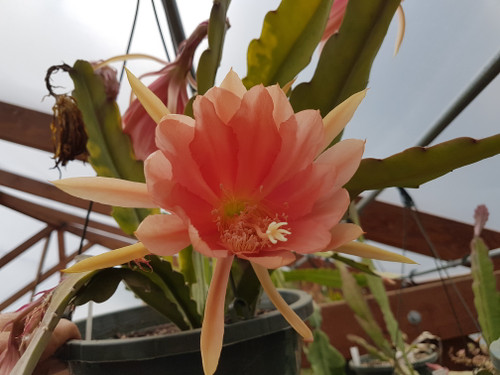Pot Size: 3.5"
Accepted Scientific Name: Epiphyllum hybrid 'Lola D'
Origin and Habitat:
Epiphyllum hybrids trace their ancestry to epiphytic cacti native to Central and South American rainforests. These plants naturally grow high in the canopy, rooting in leaf litter and moss while benefiting from filtered sunlight and humid conditions. In their native environment, the parent species thrive in loose, organic substrates with excellent drainage, supported by seasonal rains. The hybrid 'Lola D' maintains these tropical preferences, flourishing in conditions that mimic the balance of warmth, moisture, and air circulation of its natural rainforest habitat.
Description:
Epiphyllum hybrid 'Lola D' is a spectacular orchid cactus, admired for its large and striking blossoms that typically reach 6 to 8 inches across. The flowers display rich shades of pink to magenta, often with subtle lighter centers or petal edges, creating a layered and luminous effect. Its growth form consists of flat, arching, or cascading green stems that can grow 12 to 24 inches in length, making it a beautiful feature plant for hanging baskets or elevated displays. The vivid floral display combined with its lush stems makes 'Lola D' a stunning ornamental choice for indoor and greenhouse cultivation.
Cultivation:
Zone: Grows best in Zones 10–11; overwinter indoors in cooler climates.
Temperature: Optimal range is 18–30°C; avoid temperatures below 10°C.
Growth rate: Moderate, with faster growth in warm and humid conditions.
Soil: Requires a free-draining organic medium with pumice and orchid bark to prevent root rot.
Watering: Keep soil slightly moist during the growing and flowering seasons, allowing slight drying between waterings. Reduce watering during winter dormancy.
Fertilizing: Use a diluted balanced cactus or orchid fertilizer every 2–3 weeks during active growth for best results.
Light: Prefers bright, indirect sunlight; protect from direct midday sun.
Pests and Diseases: Susceptible to mealybugs, aphids, and spider mites; excessive watering can cause root or stem rot.
Propagation:
Propagation is easily achieved through stem cuttings. Cuttings should be allowed to callus before planting in free-draining soil. With warmth and light moisture, roots develop in a few weeks.








